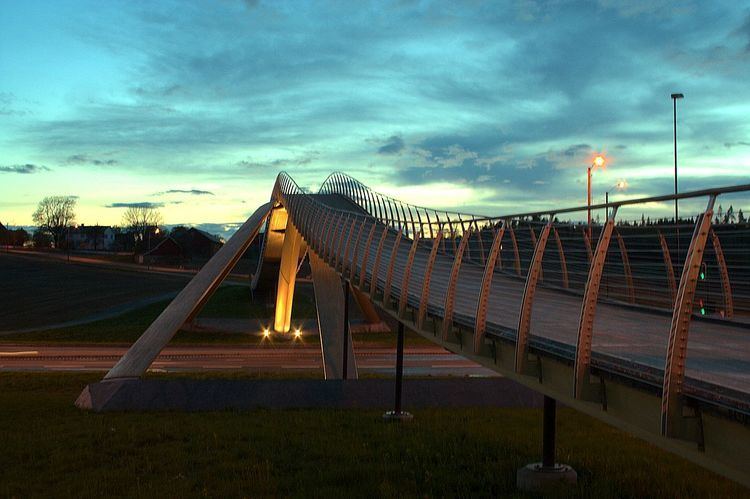Crosses Highway E-18 Total length 109 m Location Ås, Akershus | Opened 2001 Bridge type Arch bridge | |
 | ||
Carries pedestrian and bicycle traffic Locale Nygård, Ås, AkershusNorway Website www.leonardobridgeproject.org Material Laminated wood; steel-reinforced Similar Slauerhoffbrug, The Rolling Bridge, Tusenfryd, Python Bridge, Loopen | ||
The Vebjørn Sand da Vinci Project built a laminated-wood parabolic-arch pedestrian bridge in Norway over European route E18 in Ås, Norway, in 2001. It was a partnership between the Norwegian Public Roads Administration and Norwegian painter and artist Vebjørn Sand, who headed the project. The resulting da Vinci Bridge is one of several installations that Sand is known for in Norway.
Contents
Original design
Leonardo da Vinci proposed a bridge 366 m (1,201 ft) long, overall and 24 m (79 ft) wide over the Golden Horn in 1502 for Sultan Bayezid II of Constantinople (today’s Istanbul). The sketch and letter proposal were lost for over 400 years before being rediscovered in 1952. The proposed bridge included a 240 m (790 ft) "pressed bow" main span with 43 m (141 ft) of vertical clearance to allow ships to pass. da Vinci bragged that "it has been [the Sultan's] intention to erect a bridge from Galata (Pera) to Stambul… across the Golden Horn (‘Haliç’), but this has not been done because there were no experts available. I, your subject, have determined how to build the bridge. It will be a masonry bridge as high as a building, and even tall ships will be able to sail under it." The sketch was confirmed to be a genuine work of da Vinci by comparison with an identical sketch in Manuscript L, part of the Paris Manuscripts stored in the Institut de France in Paris.
Had the 1502 design been implemented, it would have been the longest bridge in the world, and it would still be the longest single masonry arch span in the world. Da Vinci is said to have been inspired by the then newly-built bridge "Ponte degli Alidosi" over Santerno at Castel del Rio near Bologna with a 42 m. high semicircular arch .
Implemented in Ås
Norwegian artist Vebjørn Sand saw da Vinci's Haliç bridge sketch in 1996 and proposed the bridge should be implemented by the Norwegian Public Roads Administration (NPRA). Since the NPRA had a policy to consider the artistic merits of public structures, a new structure was approved in 1997 to replace "Norway's ugliest bridge." Several alternative materials were considered for the bridge, including the as-designed stone and concrete, but ultimately the timber version was selected for construction. Moelven Laminated Group, who had constructed the world's largest wooden roof for Håkons Hall in Lillehammer for the 1994 Winter Olympics, was selected to supply glued laminated timber (glulam) for the new da Vinci Bridge.
The da Vinci Bridge, completed in 2001, serves as a pedestrian crossing over highway E18 in Ås, approximately 20 kilometres (12 mi) from Oslo. It was built from large prefabricated glulam sections moved in place by cranes, with three parabolic arches in the main span: a central arch supporting the pathway and two stabilizing arches flanking it. The main span is 40 m (130 ft) and the bridge is 109 m (358 ft) long, overall at a total cost of approximately 12 kr million. The completed da Vinci Bridge was built wide enough to allow four lanes of traffic underneath, but requirements for vertical clearance have increased and adding lanes of traffic would require lowering the road. The bridge was opened by Queen Sonja in a November 2001 ceremony using cranes to lift a white cloth draped over the bridge, literally unveiling it to the public.
Since its unveiling, the da Vinci Bridge has attracted attention in the New York Times. Wired called it one of the five coolest bridges on earth in 2005, along with the Rio–Antirrio bridge, the Seri Wawasan Bridge, the Dongting Lake Bridge and the Juscelino Kubitschek Bridge.
Global Leonardo Bridge Project
The Oslo Leonardo Bridge Project opened in October 2001. The project hopes to apply the design to build practical footbridges around the world using local materials and local artisans as a global public art project. Future plans, announced in 2012, include a bridge over the Golden Horn in Istanbul, as Leonardo had proposed. Sand was quoted by the Wall Street Journal describing the Bridge Project as a "... logo for all the nations."
A small da Vinci pedestrian bridge was erected in 2016 at the Château du Clos Lucé, da Vinci's home for the last years of his life. Other permanent da Vinci bridges have been proposed for several locations, although these plans have not come to fruition:
Several temporary da Vinci bridges have been built in ice since the completion of the da Vinci Bridge in Norway:
